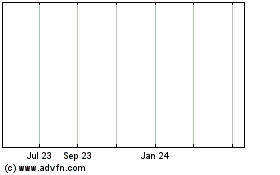Samsung to Build Odyssey VR Headset for Windows
04 October 2017 - 5:29AM
Dow Jones News
By Jay Greene
SAN FRANCISCO -- Microsoft Corp. enlisted one of the world's
largest consumer electronics makers, Samsung Electronics Co., as it
works to crack the emerging virtual-reality market.
At an event here Tuesday hosted by Microsoft, Samsung will
introduce HMD Odyssey, a virtual-reality headset that uses
Microsoft's Windows Mixed Reality, a piece of Windows 10 that
enables immersive computing through headsets and other devices.
Samsung joins Acer Inc., Dell Inc., HP Inc. and Lenovo Group
Ltd. in building headsets on top of the Windows platform. The
devices all use virtual-reality technology, which occludes users
view of the real world and immerses them in digitally generated
sights and sounds.
Samsung is an important partner for Microsoft, which is ramping
up in the virtual- and augmented-reality markets where it will
compete against Apple Inc., Alphabet Inc.'s Google, Facebook Inc.
and others. Samsung is already a leader in virtual reality with its
Gear VR device that runs Facebook's Oculus technology.
In a blog post from Microsoft, Samsung Electronics America vice
president and general manager Alanna Cotton said the company "is
committed to working across platforms."
The Odyssey, which comes with two controllers, features sharp
OLED displays, rather than the LCD displays used on lower-priced
headsets. It includes headphones and a built-in microphone, and can
be preordered for $499 on Oct. 3. It will be available Nov. 6.
Headsets from Microsoft's four other partners, which the company
had previously said would start at $399, can also be preordered
Oct. 3, and will be available Oct. 17.
Microsoft is trying to build an entire technology ecosystem for
virtual and augmented reality, and put itself at the center. It was
among the first to jump into the business, introducing its HoloLens
augmented-reality headset nearly three years ago, though the device
isn't commercially available yet.
Windows Mixed Reality, part of the Windows 10 operating system,
aims to serve as the technical underpinnings for both VR devices
and augmented-reality devices such as the HoloLens, which overlays
digital elements onto a person's view of the real world.
It is a market analysts believe is set to explode.
Market-research firm International Data Corp. forecasts sales of
13.7 million virtual- and augmented-reality headsets this year, and
expects that to jump to 81.2 million units by 2021, a compounded
annual growth rate of 56%.
Microsoft will vie with Apple, which is nudging developers to
create applications for its augmented-reality development platform,
ARKit. Google, too, is in the augmented-reality market with its
ARCore, a tool to help developers on its Android mobile-device
platform create augmented-reality apps.
Microsoft is also working to add gaming content to its
ecosystem, and in August announced a deal to bring games from Valve
Corp.'s popular Steam business to Windows virtual- and
augmented-reality devices. At the media event on Oct. 3, Microsoft
plans to give game developers access to technology that will help
them build holographic games in Steam.
Write to Jay Greene at Jay.Greene@wsj.com
(END) Dow Jones Newswires
October 03, 2017 14:14 ET (18:14 GMT)
Copyright (c) 2017 Dow Jones & Company, Inc.
Samsung Electronics (PK) (USOTC:SSNHZ)
Historical Stock Chart
From Mar 2024 to Apr 2024

Samsung Electronics (PK) (USOTC:SSNHZ)
Historical Stock Chart
From Apr 2023 to Apr 2024
